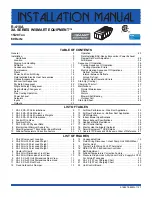
G5. EXPANSION CONTROL VALVE (ECV)
Scale deposits in water can cause TPR valves to become blocked with carbonate deposits as the scaling water
passes through the hot valve body. To prevent failure of the TPR valve, cylinders installed in areas of high scale
must have an expansion control valve (ECV) fitted on the cold supply to the water heater. The ECV must have a
pressure relief setting lower than the TPR pressure relief setting but higher than the supplied water pressure.
In this way pressure is released through the ECV valve in preference to the TPR valve. As the ECV is fitted in the
cold mains water supply line, water is cold therefore, has less chance of forming scale and becoming blocked.
The ECV should be fitted after the non return valve
Note that AS 3500.4 lists the allowable pressure ratings of the valves.
An expansion control valve IS RECOMMENDED TO BE FITTED on ALL installations with a permanently open
copper discharge pipe angled downwards towards a suitable drainage point. Water will drip from this discharge
pipe during normal operation due to expansion of water in the system.
G6. TEMPERING VALVE
The Australian Standard AS NZS 3500 requires that water from a storage hot water cylinder at some stage
reach a minimum of 60°C in order to kill and prevent the further growth of Legionella bacteria. A solar hot water
system will not always reach 60°C without some form of boost heating.
Having heated the water to 60°C it is too hot to be safe for bathrooms etc., so it must be reduced in temperature
using a tempering (thermal mixing) valve. The location of the tempering valve is an issue. It is probably easiest
to install it right at the hot water storage cylinder (or continuous unit). This has the distinct disadvantage that
water to all points of the house will be tempered
SAFETY WARNING:
A tempering valve MUST be fitted on ALL installations
10
11
For many people, water in the kitchen for washing dishes or
in the laundry for washing clothes needs to be hotter than the
maximum 50°C to which the tempering valve is set. Two pipe
lines are now required, one for hot water (at least 60°C) and
one for tempered hot water (50°C). For supply to points a long
way from the hot water store, it is best to have the tempering
valve close to the point of use. If tempered water has to travel
a long distance it will continue to lose heat and be too cool by
the time it reaches its destination.
The pressure must be the same for hot and cold water on each
side of a tempering valve. There are different tempering valves
available for different operating pressures and of course differ-
ent sizes for different flow rates. Make sure that the tempering
valve to be installed is suitable.
Figure1. A tempering valve attached directly to the cylinder. A second line is required if water in excess of 50 oC is required in the kitchen or laundry.
Summary of Contents for OZS251E
Page 1: ......
Page 2: ......
Page 20: ... FOR ILLUSTRATION PURPOSE ONLY Cold Water Valve Train Connections to Storage Tank 18 ...
Page 35: ......
Page 36: ......













































